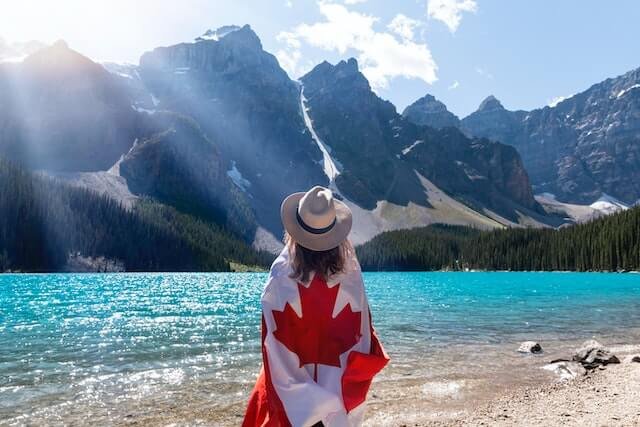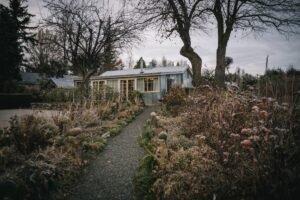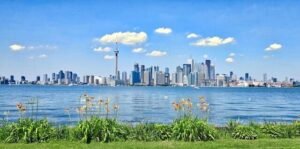As a four-decade Certified Travel Agent, international airline employee, researcher, writer, teacher, and photographer, travel, whether for pleasure or business purposes, has always been a significant and an integral part of my life. Some 400 trips to every portion of the globe, by means of road, rail, sea, and air, entailed destinations both mundane and exotic. This article focuses on those to Canada, whose coverage encompassed all 14 provinces and territories.
Labrador:
Encompassing 500,000 square miles between the Atlantic Ocean and Hudson Bay in northeastern Canada, Labrador extended further east than any other part of the North American continent. Its geological base, formed by the ancient Laurentian Shield, was created by internal upheaval, glaciation, and erosion, and is believed to resemble the surface before life on the planet began. Considered both Canada’s and the world’s last Frontier, it was sparsely populated and virtually unexplored.
Although a few venues could be considered “sights” in the traditional travel sense of the word, such as the Labrador Heritage Museum, the Labrador Military Museum, and 5 Wing Goose Bay, “attractions” consisted of those that facilitated life in this far north location, specifically the Float Plane Base and the natural topography, such as Grand Lake and the Mealy Mountains, which were observed from a high view in North West River.
Road access was provided by the 530-kiometer, gravel surface Trans Labrador Highway that stretched between Goose Bay and Labrador City. The former’s First Nation population and rustic atmosphere were respectively reflected by shops, such as Drumdance Art and Crafts, and restaurants like the Trappers Cabin, in which diners grilled their own steaks.
Newfoundland:
Newfoundland, part of the Labrador province, was crossed from end to end in a westerly direction with a rental car, from St. John’s to Clarenville, Gander, and Rocky Harbor, exceeding 700 kilometers and was followed several days later with a return.
Its several sights included Terra Nova National Park, the North Atlantic Aviation Museum, the Silent Witness Memorial, a tranquil park dedicated to the memory of the 256 who lost their lives on December 12, 1985 in an Arrow Air Super DC-8 accident, and Gros Morne National Park, where a long hike preceded a boat cruise on 15-kilometer-long Western Brook Pond and Fjord.
Gander International Airport played a significant role in the early piston airliner days as a refueling stop, since these aircraft lacked sufficient range to fly between North America and Europe, and its in-situ Hotel Gander, where countless passengers regularly stayed, reflected an even earlier aviation era with its Alcock and Brown Restaurant, named after the two British pilots who made their transatlantic crossing in 1919
Cape Spear National Historic Site marked the most easterly point in North America.
Nova Scotia:
Nova Scotia, accessed through Halifax, was characterized by the city’s shop-, restaurant-, and museum-lined waterfront, beginning at the Halifax Casino, and the Halifax Citadel National Historic Site.
Old Lunenburg was one of only two urban communities in North America designated a UNESCO World Heritage site.
Peggy’s Cove, on a rocky outcrop on the eastern shore of St. Margarets Bay, was the location of Peggys Point Lighthouse and offered a wonderful lunch of fresh fried shrimp in its restaurant.
Significant sightseeing occurred on Cape Bretton Island. A drive of the 185-mile Cabot Trail, located in northern Victoria and Inverness counties and forming a loop around the island’s tip, afforded magnificent views of the Cape Breton Highlands and the Atlantic, beginning in Baddeck, which itself was the location of the Alexander Graham Bell National Historic Site.
The Fortress of Louisbourg, another National Historic Site of Canada, was the location of a quarter reconstruction of an 18th-century French fortress.
Prince Edward Island:
Prince Edward Island, accessed through Charlottetown, was synonymous with the Anne of Green Cables House in Cavendish.
Green forested New Brunswick, on the Bay of Fundy, offered an opportunity to sample local life in St. John through its Kings Square and Prince William Street, another National Historic site.
Quebec:
Quebec represented French-speaking Canada. Historic sights, dinners, and pastries were enjoyed in Vieux-Montreal (Old Montreal), preceded by a pass of Olympic Park.
Quebec City, whose very symbol seemed to be the Chateau Frontenac, was North America’s only walled city.
Several meals enjoyed in its European-reminiscent bistros. An autumn-ablaze ascent of its Mount-Ste Annie ski lift was a highlight.
Ontario:
Ontario, a skyscraper metropolis, offered attractions such as the CN Tower. A drive around Lake Ontario, for an overnight stay in St. Catharines, preluded views of Niagara Falls and the partaking of its numerous related rides and sights. A ferry ride to Toronto Island was followed by a quadricycle negotiation of its pedestrian- and bicycle-only paths. A research trip on another occasion entailed an overnight stay in Sault Ste. Marie.
Ottawa, the seat of the Canadian government, included tours of Parliament Hill on the southern banks of the Ottawa River, and the Canada Aviation and Space Museum, Canada’s equivalent of the Smithsonian Institution’s National Air and Space Museum in Washington.
Manitoba:
Although Manitoba was accessed through Winnipeg and it afforded sightseeing opportunities at its Forks National Historic Site, it offered both natural and exotic venues, over and above the Hudson Bay Company’s stone fur trade fort in Lower Fort Garry. Riding Mountain National Park, for example, was explored with a self-drive tour through its narrow dirt roads that served as arteries through the ubiquitous tall, thin, white barked birch and poplar trees, opening up to grasslands and the Bison Range, and a boat cruise on Clear Lake was like gliding atop a sheer blue mirror.
Churchill, considered the Polar Bear Capital of the World and located on the province’s northern tip, was a deposit into subarctic Canada. A tundra buggy expedition, in a specially built vehicle internally provisioned with a furnace and externally offering an observation platform for wildlife viewing, negotiated the treeless tundra to the banks of the Hudson Bay, encountering woodland caribou, snow geese, and the polar bears themselves, which ironically viewed the tundra buggy with the same curiosity as its inhabitants viewed them.
A subsequent zodiac tour on the Churchill River afforded beluga whale watching opportunities.
Other sights included the Visitor Center in the Churchill Railroad Station, literally the end of the line for VIA Rail Canada’s Manitoba boreal forest and tundra traversing track. Shopping in this almost top-of-the-world outpost was in venues such as the Arctic Trading Company, and dinner entrees appropriately featured arctic char.
Saskatchewan:
Neighboring Saskatchewan, with its Regina and Saskatoon major gateways, offered sighting similarities and one notable difference. A drive on the dirt road penetrating Prince Albert National Park, for instance, revealed pristine vistas, while the area’s access and infrastructure could be studied at the Western Development Museum. But a stay in Moose Jaw’s Temple Gardens Mineral Spa Resort provided peace for the soul and elegant cuisine for the body, and an escorted tour through its Tunnels of Moose Jaw, an extensive system dug in 1908 and used by Chinese immigrants and during prohibition, revealed the town’s “underground” purpose.
Alberta:
Calgary and Edmonton served as the thresholds to the Canadian Rockies, which offered infinite views of the imposing, snow-streaked mountains, a visit to Banff National Park, a tram ascent of Mount Sulphur on the Banff Gondola, and the glittering blue jewel of Lake Louise. The cursory study of paleontology, as evidenced by the dinosaur skeleton outside of the Royal Tyrrell Museum, was introduced in Drumheller.
British Columbia:
Several stays at Vancouver’s Pan Pacific Hotel, part of the cruise ship terminal from which Alaska Inside Passage itineraries were launched, became the base for sightseeing in British Columbia that included Capilano Suspension Bridge Park, the Grouse Mountain and Skyride, and a ferry to and helicopter return from Victoria on Vancouver Island. The latter, showcasing its British colonial past, included such attractions as Butchart Gardens and its Victorian architecture, and high afternoon teas were still in practice.
A side trip to Whistler, one of the largest ski resorts in North America, not only offered the expected skiing, but snowshoeing, tobogganing, and ski jumping were available at its Olympic Park, a venue for the 2010 Vancouver Winter Olympics. Its pedestrian, chalet-style village at the base of the Whistler and Blackcomb Mountains provided modern, overnight accommodation, and lunch was enjoyed after an aerial tramway ride up to the summit.
Arctic and subarctic Canada was experienced in three territories, which, spanning the country from east to west, included Nunavut, the Northwest Territories, and the Yukon.
Nunavut:
The first, located on Baffin Island and served by Iqaluit, reeked of remote outpost life. Located above the tree line, it offered few roads and they led neither in nor out. Its community center appeared like a self-contained module from Moon Base Alpha. And it was one of the few “cities” with regularly scheduled airline service to Greenland.
Northwest Territories:
Yellowknife, the largest population center of the Northwest Territories on the Mackenzie River and itself above the 60th parallel, was marked by floatplanes serving as aerial arteries to its remote communities and caribou served in the log cabined Wildcat Café, although more traditional fare was available in more modern hotels and restaurants.
Buffalo Airways, with its fleet of antiquated Douglas DC-3s, Curtiss C-46 Commandos, Douglas DC-4s, and Lockheed Electras, was the supply lifeline to the area’s other communities.
Norman Wells rapidly expanded because of its oil deposits.
And Inuvik, above the Arctic Circle, was accessed by the gravel Dempster Highway, which connected the area with Dawson City in the Yukon and facilitated a day trip, in a rental truck, to Detah, itself requiring a brief ferry crossing of Arctic Red River to reach.
Yukon:
The Yukon afforded an extensive, multi-faceted travel experience. In Whitehorse, its largest city, it included a stay in a hotel featuring Klondike gold rush décor; visits to the Old Church Museum, the now-stationary S. S. Klondike, the largest of the 250 sternwheelers to have plied the Yukon River and a National Historic Site of Canada. Other attractions included the Yukon Transportation Museum, the Yukon Beringia Interpretative Center (Beringia having been the subcontinent of the last Ice Age), and the Whitehorse Fish Ladder. A ride on the Copper Belt Mining Railroad, the Whitehorse Waterfront Trolley, and a boat cruise to Miles Canyon on the Yukon River served as both attractions and transportation modes, and a performance of the Frantic Follies Vaudeville Revue cemented the gold rush experience.
Side trips entailed those to Haines Junction, where a stay in the Raven Hotel, owned and run by Germans who made the daily breakfast and cooked each individual dinner, and Kluane National Park, a subarctic wilderness preserve.
A drive on the Alaska Highway, past Carcross, led to the US border and Skagway, Alaska, for a ride on the famed White Pass and Yukon Route Railroad.
Article Source: https://EzineArticles.com/expert/Robert_Waldvogel/534926
Article Source: http://EzineArticles.com/10389227




